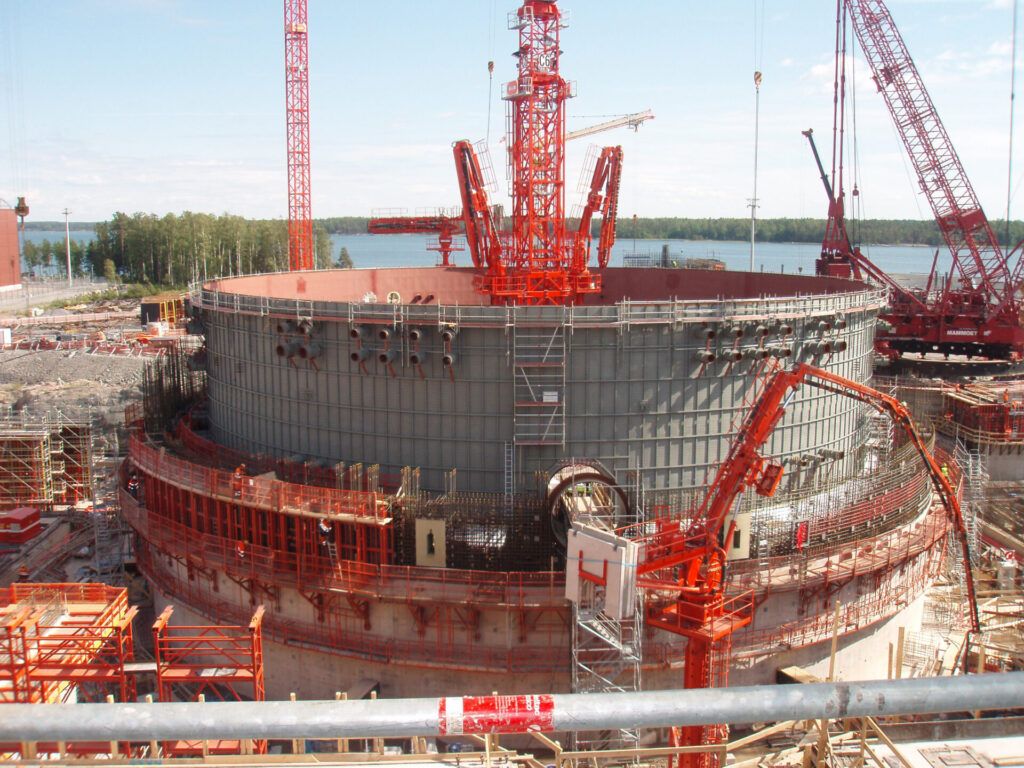Eastern Europe’s purchase of US nuclear reactors is primarily about military ties, not climate change
By Maha Siddiqui, M.V. Ramana | August 2, 2024
 In recent years, Eastern European countries have announced plans to import US nuclear reactors. But these plans hide huge increase in imports of US military technology and hosting of US weapons, which will expand US military presence and influence in the region. (Image: New reactor construction site in Finland in 2007. Credit: US NRC, via Flickr)
In recent years, Eastern European countries have announced plans to import US nuclear reactors. But these plans hide huge increase in imports of US military technology and hosting of US weapons, which will expand US military presence and influence in the region. (Image: New reactor construction site in Finland in 2007. Credit: US NRC, via Flickr)
The nuclear industry hasn’t been so excited in a while. From the pledge to triple nuclear energy by 2050 made by around 20 countries during the 28th UN climate summit in Dubai, United Arab Emirates to the recent report to the G20 by the International Atomic Energy Agency on speeding up investment into nuclear power to meet net zero goals, there is much talk about a new round of nuclear reactor construction.
Countries in Eastern Europe, such as Poland, are active participants in this effort to rebrand nuclear energy as clean and climate friendly. Poland’s inclusion in this list should be surprising: Its electricity primarily comes from fossil fuels, and the country has not committed to any net-zero target, making it “the lowest-placed EU nation” in its ability to reach net zero emissions by 2050. Nevertheless, in 2023, Poland’s government announced plans to import nuclear reactors.
Even though it promotes nuclear power as a way to meet climate goals, Poland and other countries in Eastern Europe seem to be using nuclear purchases for geopolitical leverage with the United States. That desire is evident in their parallel actions in the military front. Given the ongoing war in Ukraine and tensions in multiple parts of the world, the combination of geopolitics and nuclear technology may prove dangerous, even as it is ineffective at mitigating climate change.
Nuclear talk. In recent years, Poland has entered into a number of agreements to build nuclear reactors, including the in-vogue small modular reactors (SMRs) from the United States and large reactors from South Korea. Poland has attempted to build nuclear reactors in the past—in 2009, then-Prime Minister Donald Tusk announced plans to build two nuclear plants, with the first to begin operating in 2020. Those plans went nowhere.
Seen in that light, the rash of recent announcements have a desperate ring to them. Not surprisingly, Tusk has continued to advocate for building nuclear reactors, stating in November 2023 that Poland had to pursue nuclear energy “as quickly as possible.” But he has pushed back plans to start construction: The “first pour of concrete”—which is the traditional marker of project initiation—is now scheduled for 2028, two years after the earlier projected date of 2026.
Romania has taken a somewhat similar path. In 2021, on the sidelines of the 26th UN climate conference in Glasgow, Romanian officials signed a cooperation agreement on small modular reactors with NuScale Power. At that time, Romanian Energy Minister Virgil Popescu talked about developing SMRs “to meet [Romania’s] critical energy demand and green targets and to secure a quality future for the generations to come.” (Since then, NuScale’s first proposed SMR project in the United States has collapsed because of massive cost increases, and it is uncertain if the Romanian project will move forward.)
Military linkages. For countries like Romania and Poland, the rationale offered for supporting nuclear energy, namely climate mitigation, is just one face of the coin. A parallel set of military developments are also at play.
In April, Poland President Andrzej Duda publicly expressed a readiness to host NATO nuclear weapons. In an interview published in a Polish news outlet, he revealed that nuclear sharing had been discussed with the United States “for some time.” Although not widely noted at that time, the previous Prime Minister Mateusz Morawiecki had also indicated an “interest in hosting nuclear weapons under NATO’s nuclear-sharing policy.”
The interest in hosting nuclear weapons aligns with Poland’s efforts to position itself as close to the West ever since the collapse of the Soviet Union. Among countries that were formerly part of the Warsaw Pact with the Soviet Union, Poland was among the first three countries to join NATO, together with Hungary and the Czech Republic.
Poland also tied itself militarily to the United States by becoming part of US missile defense infrastructure. The process started during the George W. Bush administration and continued through the successive US presidencies. Most recently, as part of the Biden administration’s 2024 budget for defense, the Missile Defense Agency requested funding to complete construction of a site in Poland to deploy the Aegis Ashore missile defense system and purchase missiles for this site.
Poland has emerged as one of Europe’s largest importers of military equipment, second only to Ukraine, buying military equipment worth billions of dollars from the United States. In the 2023 fiscal year alone, Poland purchased Apache Helicopters ($12 billion), High Mobility Artillery Rocket System ($10 billion), Integrated Air And Missile Defense Battle Command System ($4 billion), and M1A1 Abrams Main Battle Tanks ($3.75 billion).
Such significant imports are a good indicator that the country is seeking to ally with the United States. While Poland still lags far behind traditional US allies and arms importers like Saudi Arabia, South Korea, and Australia, Poland is rapidly expanding such imports. The country’s military spending in 2023 was 75 percent higher than in 2022 and 181 percent higher than in 2014. Poland was also among the world’s 20 largest importers of weapons in the 2019-2023 period, with its share of imports jumping four-fold compared to the previous 2014-2018 period. Of these imports, nearly half came from the United States.
US officials see the purchase of military equipment as one of the many ways the United States can bring Poland closer in geopolitical terms. Another is to have them buy US nuclear reactors.
In its “Integrated Country Strategy” for Poland from June 2022, the US State Department’s top two mission goals were stated to involve military engagement and adoption of new energy technology, including nuclear power. The document praises the “potential partnership with the United States to develop large-scale nuclear power plants with US technology” because it “could result in over $18 billion dollars in US exports and strategically tie our two countries even more tightly together over the coming century.” It should be clear who would profit most at the expense of the Polish public.
The United States has historically tried to use nuclear development to expand its empire and influence. During the Cold War, US nuclear power companies “had a specific agenda to promote the advancement of nuclear technology in non-communist countries,” which was one reason they exported nuclear reactors to South Korea.
By all evidence, the focus on nuclear energy in Eastern Europe appears not to be driven mainly by climate change but by old-fashioned geopolitics in significant proportion. Were the urgency of climate change really driving investment in nuclear energy, Poland should have considered purchasing reactors also from Russia or China. In fact, over the past decade, Russia has dominated the export market for nuclear power plants and China has built more nuclear plants than any other country.
Why it matters. The geopolitical framing of imports of nuclear energy is a problem, especially in Eastern Europe where there is an active war in neighboring Ukraine. Building up military forces using US technology and expanding US military presence in the region, even possibly basing nuclear weapons in Poland, may increase the likelihood of a catastrophic war between Russia and NATO. Such a war would be compounded by the potential for radioactive contamination from deliberate or inadvertent attacks on nuclear reactors, as illustrated by the Zaporizhzhia nuclear plant in Ukraine, which Russia has occupied since March 2022 and used as a source of leverage.
Such geopolitical games also make dealing with climate change much more difficult. A geopolitical view, by its very nature, conceives of problems essentially as a zero-sum competition: Countries will avoid cooperating with each other. But as happened with the global response to the COVID-19 pandemic, the lack of cooperation will undermine the chances of quickly reducing global emissions.
The analyst and disarmament activist Andrew Lichterman recently explained that anyone interested in a more fair, peaceful, and ecologically sustainable global society should avoid using “the conceptual frame of geopolitics” which “is limited to the imperatives of holding and deploying power in what is portrayed as an endless, inevitable struggle for dominance among the world’s most powerful states.”
Investments in nuclear power in Eastern Europe hide geopolitical and military motivations behind a smoke screen of fighting climate change. When these motivations result in the massive acquisition of military equipment, manufacturing and operating them will increase carbon dioxide emissions. Worse, military buildups will also increase the risk of conflict, potentially leading to a catastrophic war that could involve nuclear weapons.
Together, we make the world safer.
The Bulletin elevates expert voices above the noise. But as an independent nonprofit organization, our operations depend on the support of readers like you. Help us continue to deliver quality journalism that holds leaders accountable. Your support of our work at any level is important. In return, we promise our coverage will be understandable, influential, vigilant, solution-oriented, and fair-minded. Together we can make a difference.
Keywords: COP26, Energy geopolitics, Europe, Poland, Romania, United States, arms sales, climate change, cop28, nuclear energy, small modular reactors
Topics: Nuclear Energy
















